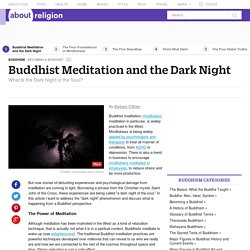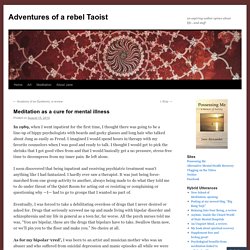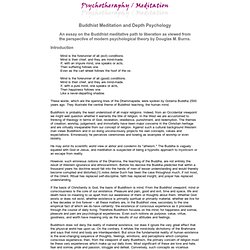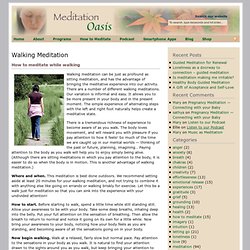

Buddhist Meditation and the Dark Night of the Soul. Buddhist meditation, mindfulness meditation in particular, is widely practiced in the West.

Mindfulness is being widely applied by psychologists and therapists to treat all manner of conditions, from ADHD to depression. There is also a trend in business to encourage mindfulness meditation in employees, to reduce stress and be more productive. But now stories of disturbing experiences and psychological damage from meditation are coming to light. Borrowing a phrase from the Christian mystic Saint John of the Cross, these experiences are being called "a dark night of the soul. " In this article I want to address the "dark night" phenomenon and discuss what is happening from a Buddhist perspective. How to Meditate Daily. Post written by Leo Babauta.

The habit of meditation is one of the most powerful things I’ve ever learned. Amazingly, it’s also one of the most simple habits to do — you can do it anywhere, any time, and it will always have immediate benefits. How many habits can you say that about? While many people think of meditation as something you might do with a teacher, in a Zen Center, it can be as simple as paying attention to your breath while sitting in your car or on the train, or while sitting at the coffee shop or in your office, or while walking or showering. It can take just one or two minutes if you’re busy. Why Meditate? A Brief Guide to Meditation for Parents. My purpose with this post is to help busy moms and dads find a quick relief from whatever causes any stress in their life.

I hope you all see that meditation has countless benefits, can take as much or little time as you want to devote to it, and there’s no way of doing it wrong. In our overstimulating world filled with stress, smartphones, marketing everywhere, facebook, stress, deadlines, work, stress, meditation is the one thing guaranteed to offer you relief. I started my meditation practice a few years ago. It involved just sitting down uncomfortably and trying to focus on my breath. Which was really, REALLY hard to do and didn’t work out very well for me. Secular Meditation: “If you can’t meditate for twenty minutes a day…” “You should sit in meditation for twenty minutes every day — unless you’re too busy.

Then you should sit for an hour.” -Zen proverb Almost as soon as I started meditating, I started hearing this proverb. It pops into my mind now and then: usually when I’m struggling with (or simply looking at) how to find time to practice every day, in a life that’s both overly packed and highly irregular. How to Meditate at Any Time without Meditating. “If we are not fully ourselves, truly in the present moment, we miss everything.”

~Thich Nhat Hanh Flour. Meditation. Meditation as a cure for mental illness. In 1989, when I went inpatient for the first time, I thought there was going to be a line-up of hippy psychologists with beards and geeky glasses and long hair who talked about Jung as easily as Freud.

I imagined I would spend hours in therapy with my favorite counselors when I was good and ready to talk. I thought I would get to pick the shrinks that I got good vibes from and that I would basically get a no pressure, stress-free time to decompress from my inner pain. Be left alone. I soon discovered that being inpatient and receiving psychiatric treatment wasn’t anything like I had fantasized. How to Meditate: What you didn’t know about Empty Mind Techniques and your bliss. Sow a thought and you reap an act; Sow an act and you reap a habit; Sow a habit and you reap a character; Sow a character and you reap a destiny. Empty mind meditation is one of the most popular and yet misunderstood types of meditation. I love it because it trains you to still (or control, depending on what you want) your thoughts and emotions.
Why should this matter? Your very destiny begins in your thoughts. Your very happiness begins in your emotions – combined with your thoughts, they take you up to heaven or down to hell. Empty mind meditation is also a neutral form – it is free of all the different teachings and belief systems, so everyone can practice it without getting sucked into something they might not want to.
I’ve been asked a few times about my favourite meditations, so I’ll describe it here, with a few personal variations. If you’re an experienced meditator, you can skip the next few sections and get straight to the goods. Merkabah (Star Tetrahedron) Meditation. Merkaba Meditation Technique. The Double-Tetrahedron Technique & Meditation.
John Cage on multi-attentive meditation. The Worst Horse / Amanda Palmer of The Dresden Dolls on "Melody vs. Meditation" Alan Watts Teaches Meditation. 16 labyrinths worth exploring. Labyrinths have long been used by mystics and the clergy as a tool for meditation and prayer.

Today, more and more people of all denominations are drawn to these contemplative coils. Labyrinths as a spiritual device are nothing new. Between 3,500 to 5,000 years ago, it was thought that evil spirits could only travel in straight lines. A labyrinth, with its winding circuits, provided protection in a safe, sacred space. Although the words “labyrinth” and “maze” are often used interchangeably, they are not the same. Buddhist Meditation and Depth Psychology. An essay on the Buddhist meditative path to liberation as viewed from the perspective of modern psychological theory by Douglas M.

Burns. Introduction Mind is the forerunner of all (evil) conditions. Mind is their chief, and they are mind-made. If, with an impure mind, one speaks or acts, Then suffering follows one Even as the cart wheel follows the hoof of the ox. These words, which are the opening lines of the Dhammapada, were spoken by Gotama Buddha 2500 years ago. Buddhism is probably the least understood of all major religions.
He may extol its scientific world view or abhor and condemn its "atheism. " However, such erroneous notions of the Dhamma, the teaching of the Buddha, are not entirely the result of Western ignorance and ethnocentrism. If the basis of Christianity is God, the basis of Buddhism is mind. Buddhism does not deny the reality of material existence, nor does it ignore the very great effect that the physical world has upon us. How to do a walking meditation. How to meditate while walking Walking meditation can be just as profound as sitting meditation, and has the advantage of bringing the meditative experience into our activity.

There are a number of different walking meditations. Our variation is informal and easy. It allows you to be more present in your body and in the present moment. The simple experience of alternating steps with the left and right foot naturally helps create a meditative state.